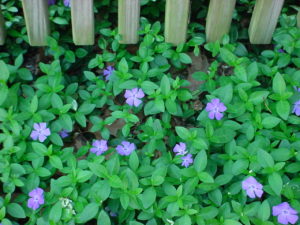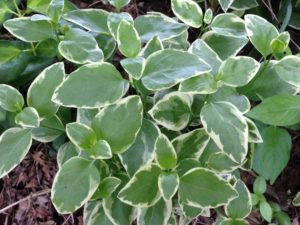
Vinca minor is a plant with a high potential for an invasive habit. Do not plant!
Photo provided by Rosie Lerner, Purdue Extension.
People often select plants first for their beauty and second for their functionality in the garden. Frequently, we don’t know or don’t consider a plant’s behavior when we’re selecting them.
Almost by definition, a species that is an effective ground cover will have a spreading habit. But does that make the species aggressive or invasive? There can be much confusion about the meaning of the terms aggressive and invasive.
Some plants, given their optimal habitat, can become quite prolific in the garden. A plant can be considered aggressive if it spreads and has the potential to take over a garden area. However, some planting sites may call for an aggressive habit.
A spreading plant can be considered invasive if it can also escape the garden setting and move into natural areas (prairies, wetlands, and so on) and displace native vegetation. Truly invasive plants have the potential to dominate natural vegetation.
Many useful plants get bad reputations for their spreading behavior when they may simply be in the wrong place or managed the wrong way.
Some spreading ornamental plants have a high propensity for becoming invasive. You should always avoid using these plants in the landscape. The publication we link to below lists some of these plants to avoid.
As you consider what to plant, it may seem that more and more plants are classified as invasive — and you would be correct. There are more invasive plants for several reasons, including an increasingly unstable climate, more gardeners who unwittingly plant invasives, greater scrutiny of invasives, and changes in species (that is, individual species have adapted to cooler or warmer environments).

Vinca major is a plant with a high potential for an invasive habit. Do not plant!
Photo provided by Rosie Lerner, Purdue Extension.
To help you make better informed plant selections, we recently revised our publication Spreading Ornamental Plants: Virtues and Vices (Purdue Extension publication HO-295-W, formerly HLA-1-W).